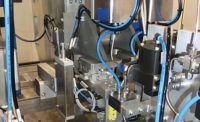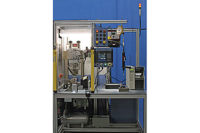On Nov. 6, 2000, President Clinton signed a law requiring health care facilities to use syringes and catheters with retractable needles to help prevent needle-related injuries and infections.
The law was no surprise to medical device manufacturer Becton, Dickinson and Co. (BD, Franklin Lakes, NJ). The company saw it coming in 1998 and recognized that it would be both an opportunity and a challenge. If the company was to capitalize on that opportunity, it would have to reconfigure its operations from assembling traditional "sharps" to the new, more complicated safety devices--and do it quickly. The company would have to go from virtually no production to billions of units in less than 3 years.
The numbers are staggering: Health care workers perform 1.4 billion skin injections and 750 million blood draws annually in the United States. To meet that demand, BD's assembly lines for blood collection needles would have to make more than 350 million units per year. The lines for safety needles would have to produce more than 500 million units per year. And the catheter lines would have to make more than 75 million units per year.
To complicate matters, safety sharps are more complex than traditional sharps. A standard syringe or catheter might consist of four to six parts. One with a retractable needle might have 12 to 15 parts. "To a lot of industries, that's not a lot of parts to handle. But to us, it was a big, big change," says William A. Kozy, BD's senior vice president for manufacturing.
And, of course, the assembly process would have to meet the same sterilization and packaging requirements as the assembly process for traditional sharps.
How BD solved these challenges is as much a story of corporate cooperation and leadership as it is one of successful manufacturing and design engineering.
Capturing the Market
Founded in 1897, BD has seen innumerable changes in medical technology and economics. The switch to safety sharps isn't the first time the company has dealt with the problem of consumer demand shifting dramatically from one style of product to another. In 1962, for example, the company led the way when the health care industry switched from glass syringes to plastic ones.
To succeed in a changing market, manufacturers cannot be afraid to make their traditional products obsolete. Wanting to be first in the developing market for safety sharps, BD invested heavily in R&D for the devices. The company introduced the first advanced protection needle product in 1989, well before their use was mandated by federal law. Today, the company manufactures the most widely accepted safety products.
BD defined the market for safety sharps in other ways, as well. During the past several years, the company sponsored educational programs and research, which helped build awareness of the need for the new devices. It also supported state and federal legislation requiring needle safety programs.
Kozy believes these efforts created a sense of urgency within the company to increase production of the safety sharps.
"Once we saw that several states were passing [needle safety] laws, we realized it was only a matter of time before the federal government passed one," says Kozy. "That gave us a sense of planning and cooperative energy that we hadn't seen before. We recognized that our entire base of production, which had been making nonsafety products, had to be changed in 20 or 30 months.
"Urgency is a funny thing. It created a catalytic environment, and people realized they had to get in rooms together. The cooperation between manufacturing, marketing and R&D was unprecedented."
Nearly 2 years before Congress passed the needle safety legislation, BD committed more than $300 million to retool and upgrade its manufacturing facilities to meet the expected increase in demand for safety sharps.
The first step, says Kozy, was to find some space to assemble the new products. The company identified which of its plants had the production capability and technical resources to manufacture the safety sharps. It then relocated established product lines out of those plants and into others. The new products will be assembled at BD's plants in Caanan, CT, Broken Bow, NE, Sandy, UT, and Sumter, SC.
"We worked across the company, rather than by individual businesses, which would have been our normal approach," says Kozy.
Catheter Assembly
Once the company decided where the new products were to be assembled, the next step was to acquire the technology to assemble them. Because the company's equipment needs exceeded the capacity and capability of its key automation technology suppliers, BD sought new partners. In some cases, the company selected technology suppliers that were new to medical device assembly.
"Our biggest technology breakthroughs and benefits came from new partners," Kozy says.
Some of those breakthroughs are evident in the new automated assembly systems at BD Medical Systems in Sandy, UT, where the company's safety catheters are produced. The three systems that were installed at the plant in June, July and October 2000 represent the culmination of 22 months of effort.
BD's safety catheter has been available since 1995. But, because it was more expensive than standard catheters, BD had not needed to assemble the device in very large quantities. As a result, BD initially used semiautomatic equipment to assemble the safety catheters. The investment enabled BD to prove processes that would later be incorporated into the fully automatic assembly systems.
A catheter is a thin plastic tube that is inserted into a blood vessel to permit the injection or withdrawal of fluids. The catheter is packaged with--or more specifically, over--a needle. The needle does the work, puncturing the skin and guiding the catheter into the vessel. When the needle is withdrawn, the catheter remains.
The danger to health care workers lies in the time after the needle is withdrawn and before it is placed in a protective disposal container. Workers who are stuck with an exposed needle risk contracting a bloodborne infection. And, because a catheter needle typically holds more blood than a syringe needle, the chances of contracting an infection from an accidental needle-stick are greater.
In BD's safety design, the needle is attached to a spring within a clear plastic housing. With the press of a button, the entire needle quickly retracts into the housing, eliminating the possibility of accidental injury. The old catheter design consisted of seven components; the new design has 12.
The principles of design for manufacture and assembly (DFMA) were critical to the success of the assembly system. "DFMA forces you to look at the payback period, the number of parts, the number of part types--even the type of plastic used," says C. Brett Davis, director of engineering and technology at the Sandy facility.
Beyond the need to develop a product that was easy to assemble automatically, the safety catheter posed other interesting design challenges. For example, how fast should the needle retract? If it retracts too quickly, potentially infectious blood could spatter out of the needle. Similarly, the needle cannot retract too slowly, because the longer it's exposed, the greater the chance it can accidentally stick someone.
The safety catheter also presented assembly problems. The old catheter model had been around for 15 years, and some of the technology used to assemble it was unsuitable for the new model. In addition, some new processes were necessary. For example, BD had to add a process for winding the spring that retracts the needle. BD also wanted to improve the way the needles were honed and inserted.
Flexible Assembly
According to Davis, BD did many things right in acquiring the new systems, beginning with choosing the machine builder. Once the company narrowed its list of potential builders to four candidates, Davis and his engineering team visited each one. "Our mechanical engineers met with their mechanical engineers; our control engineers met with their control engineers," Davis recalls. "We wanted to make sure we got somebody we could work with."
That cooperation didn't stop after BD picked the winning bid. (BD prefers to keep the name of the machine builder confidential.) "We put a lot of energy into helping the builder understand our processes," says Cal Alexander, vice president of operations for infusion therapy, anesthesia and surgical systems at BD Medical Systems in Sandy. "The systems have come up to speed quickly because of all the up-front work we did."
Staff from BD's design, molding and manufac- turing departments par- ticipated in design reviews of the proposed system. Even machine operators contributed.
Because the safety catheters are more complex than the standard versions, BD chose--for the first time--to use asynchronous automation platforms to assemble them. "The classic, high-speed, high-volume production line was simply not going to work as well," says Kozy. "It was not going to be easy to balance that type of line and ensure high productivity."
With an asynchronous automated assembly line, BD can have multiple stations producing subassemblies at their own pace. Catheter subassemblies are loaded onto pallets and transferred from station to station on edge-style conveyors. Subassembly pallets are then routed to a separate line for final assembly. The line is balanced by varying pallet size and by controlling the time that pallets wait on conveyors.
Flexibility was another reason for using an asynchronous assembly system instead of a synchronous one. BD's safety catheter is available in 12 different needle gauges, or bore sizes, and each needle gauge comes in two lengths.
"We wanted to handle all sizes on the same platform," says Davis. "Asynchronous technology helped us improve changeover time."
Indeed, changeover on the old catheter assembly line required one or two shifts. With the new line, changeover takes 3 hours with minimal stabilization time, Davis says.
Flexibility was built into the assembly line in many ways. Tooling for different models is kept at each station and can be swapped with minimal effort. A parts feeding station is equipped with two vibratory feeder bowls, each dedicated to a particular model size. To change from one part size to another, an operator simply flips a switch to activate the correct bowl, instead of emptying and refilling one bowl.
Building flexibility into the line will also pay dividends in the future. Davis, who came to BD from disk-drive manufacturer Iomega, was all-too familiar with how short product life cycles can be. "The catheter assembly lines were designed with the next generation of product in mind," he says.
Throughout the assembly line, machine vision systems verify that parts have been assembled correctly and that they meet alignment and measurement tolerances. At the final assembly station, for example, a vision system checks that the tip of the catheter and the tip of the needle are within a very exact tolerance. "If the catheter is too long, the needle can't penetrate the skin," says Davis. "If it's too short, the catheter will catch on the skin as it enters, which is painful."
Monitors on each assembly station track the machine's uptime, performance rate and quality rate. This data is fed into a central computer on the shop floor that calculates overall equipment effectiveness.



